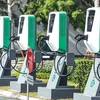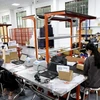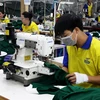Vietnam's capital market should be developed to handle the mid- and long-term credit demand of the economy, and leave the management of short-term credit and financial services to the banking system.
The suggestion put forward by bankers and economists is aimed at taking the pressure off balance sheets and volatile capital structures at banks that use short-term deposits to do mid- and long-term lending.
Vietnam's financial market has developed exponentially, yet the development is largely dependent on bank credit, Nguyen Thi Kim Thanh, head of the central bank's Banking Strategy Institute, was quoted as saying by Thoi Bao Kinh Te Viet Nam (Vietnam Economic Times).
Domestic outstanding loans are equivalent to 104.9 percent of the GDP, which is 6.5 times higher than the total value of the bond market and triples the capitalisation value of the stock market. The country’s GDP stood at 170 billion USD in 2013 and 141 billion USD in 2012.
The State Bank of Vietnam's statistics revealed that mid- and long-term money constituted 30-35 percent of the total deposits, but mid- and long-term credit accounted for more than 40 percent of the total demand.
BIDV Chairman Tran Bac Ha was quoted by the newspaper as saying that banks take liquidity risks by using short-term deposits to facilitate mid- and long-term loans. This practice causes pressure on the central bank to re-finance or provide additional capital to banks via Open Market Operation (OMO) at more frequent intervals by the year-end period.
While banks' sources fall short of credit demand, the capital market is not adequately developed and in need of urgent assistance.
Government bonds, which constitute 90 percent of the bond market, including State Treasury bonds and notes, Government-guaranteed bonds, local authority guaranteed bonds, only manage to meet 16 percent of the credit demand.
Moreover, these tools are almost held as safe reserves by major credit institutions, such as BIDV, Vietcombank, Agribank, and Vietinbank until they mature. Credit that banks injected into government bonds reportedly reached 65 trillion VND (3 billion USD), up 0.1 percent by the end of the first quarter this year as compared to the end of 2013.
After bond sales, however, mobilised money often makes a round trip within the state treasury and banks that also bore fees.
Ha suggested that the State and Government should chalk out plans to use capital mobilised from bond sales, such as public investment projects.
Tran Hoang Ngan, a member of the National Advisory Council on Monetary and Financial Policies, emphasised that it is not just necessary to fix regulations for the stock market, but also pay more attention to revive the government bond market.
Ngan proposed sellers to diversify maturities and to make pre-sale information available to the public in order to help investors to be better prepared. Post-sale policies are also required to boost transactions in the secondary market.
In the meantime, the corporate bond market recorded a good performance last year, and Vietnam is aiming higher by organising its technical and legal grounds in order to be well-prepared to facilitate issuers. Vietnam's corporate bond market featured the participation of 20 issuers, but just one-fourth are active in the market.
The Ministry of Finance plans to mobilise up to 35 trillion VND (1.65 billion USD) from corporate bonds this year, up 1.8 percent against 2013.
Last year, the volume of corporate bonds sold was 34.41 trillion VND (1.62 billion USD), up 19.87 percent against 2012, 37.64 percent against 2011, and 14.7 percent against 2010.-VNA
The suggestion put forward by bankers and economists is aimed at taking the pressure off balance sheets and volatile capital structures at banks that use short-term deposits to do mid- and long-term lending.
Vietnam's financial market has developed exponentially, yet the development is largely dependent on bank credit, Nguyen Thi Kim Thanh, head of the central bank's Banking Strategy Institute, was quoted as saying by Thoi Bao Kinh Te Viet Nam (Vietnam Economic Times).
Domestic outstanding loans are equivalent to 104.9 percent of the GDP, which is 6.5 times higher than the total value of the bond market and triples the capitalisation value of the stock market. The country’s GDP stood at 170 billion USD in 2013 and 141 billion USD in 2012.
The State Bank of Vietnam's statistics revealed that mid- and long-term money constituted 30-35 percent of the total deposits, but mid- and long-term credit accounted for more than 40 percent of the total demand.
BIDV Chairman Tran Bac Ha was quoted by the newspaper as saying that banks take liquidity risks by using short-term deposits to facilitate mid- and long-term loans. This practice causes pressure on the central bank to re-finance or provide additional capital to banks via Open Market Operation (OMO) at more frequent intervals by the year-end period.
While banks' sources fall short of credit demand, the capital market is not adequately developed and in need of urgent assistance.
Government bonds, which constitute 90 percent of the bond market, including State Treasury bonds and notes, Government-guaranteed bonds, local authority guaranteed bonds, only manage to meet 16 percent of the credit demand.
Moreover, these tools are almost held as safe reserves by major credit institutions, such as BIDV, Vietcombank, Agribank, and Vietinbank until they mature. Credit that banks injected into government bonds reportedly reached 65 trillion VND (3 billion USD), up 0.1 percent by the end of the first quarter this year as compared to the end of 2013.
After bond sales, however, mobilised money often makes a round trip within the state treasury and banks that also bore fees.
Ha suggested that the State and Government should chalk out plans to use capital mobilised from bond sales, such as public investment projects.
Tran Hoang Ngan, a member of the National Advisory Council on Monetary and Financial Policies, emphasised that it is not just necessary to fix regulations for the stock market, but also pay more attention to revive the government bond market.
Ngan proposed sellers to diversify maturities and to make pre-sale information available to the public in order to help investors to be better prepared. Post-sale policies are also required to boost transactions in the secondary market.
In the meantime, the corporate bond market recorded a good performance last year, and Vietnam is aiming higher by organising its technical and legal grounds in order to be well-prepared to facilitate issuers. Vietnam's corporate bond market featured the participation of 20 issuers, but just one-fourth are active in the market.
The Ministry of Finance plans to mobilise up to 35 trillion VND (1.65 billion USD) from corporate bonds this year, up 1.8 percent against 2013.
Last year, the volume of corporate bonds sold was 34.41 trillion VND (1.62 billion USD), up 19.87 percent against 2012, 37.64 percent against 2011, and 14.7 percent against 2010.-VNA



















